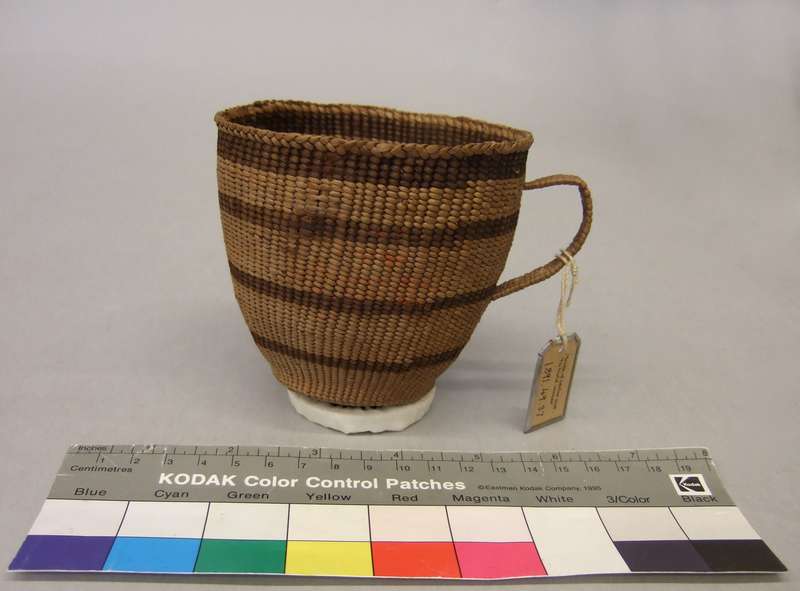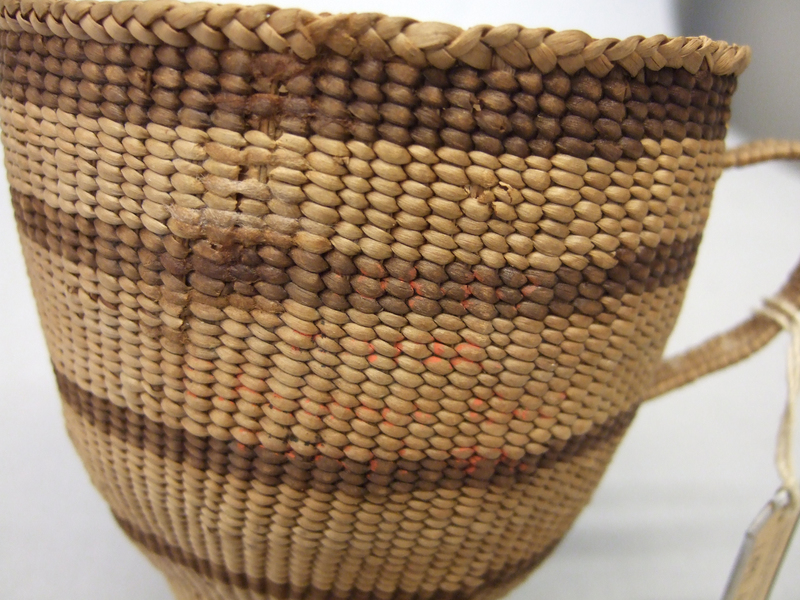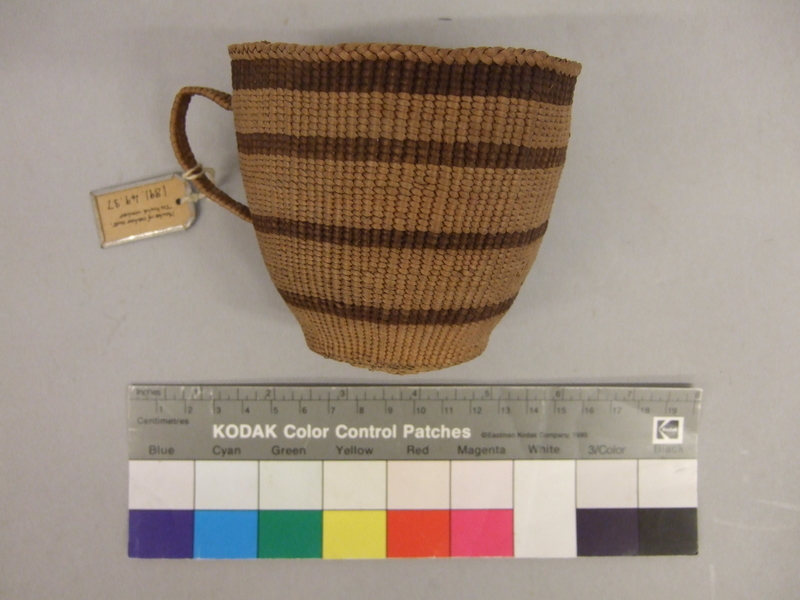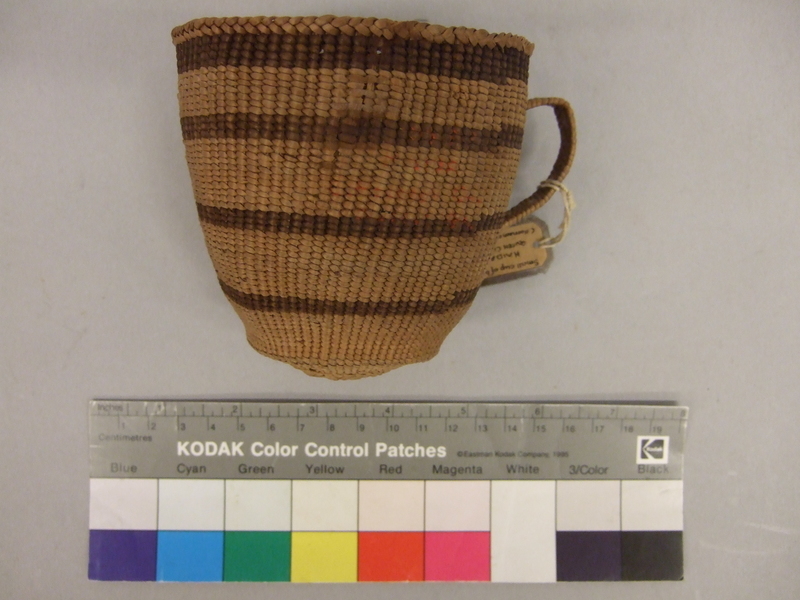Cup Item Number: 1891.49.37 from the Pitt Rivers Museum




Description
Cup with handle woven from spruce root and decorated with four dark bands. [CAK 10/06/2009]
Display History
Exhibited in Basketmakers: Meaning and Form in Native American Baskets at PRM (16 June 1992 to May 1993). [? LMM, undated / JC 4 9 1996]
Longer Description
Cup with handle woven from spruce root and decorated with four dark bands. [CAK 10/06/2009]
Publications History
Referred to on p. 9 of 'Haida Art in the Pitt Rivers Museum, Oxford, and the Rev. Charles Harrison', by June Bedford, in European Review of Native American Studies, Vol. XII, no. 2 (1998), pp. 1-10. [JC 16 4 1999]
Primary Documentation
Accession book entry: - From Rev. Ch. Harrison, 80 Halton Rd, Canonbury Sq. N. Collection of Haida objects collected by him.... - ... cup ... of spruce work. £45 [Purchases price includes 1891.49.1-110]
Accession book entry [Red numbers] - Containers other than pottery 104 A - L - Containers other than Pottery: (104 F 7) Cup made of cedar-root basket-work, with loop handle at the side, evidently modelled upon the European tea-cup - used for holding liquids. Haida, Queen Charlotte Islands. Obtd. by Rev. C. Harrison. Purchased from him 1891. March
No additional information on catalogue cards. [JC 4 9 1996]
Pitt Rivers Museum label - Small cup of basket work HAIDA QUEEN CHARLOTTE IS C. Harrison coll. Purch. 1891. [on reverse] Made of cedar root; To hold water [CAK 10/06/2009]
Related Documents File - The Haida Project Related Documents File contains video of research sessions and interviews with Haida delegates from September 2009 as part of the project ‘Haida Material Culture in British Museums: Generating New Forms of Knowledge'. It also includes post-visit communications that discuss object provenance. For extensive photographic, video, and textual records documenting the Haida research visit as a whole, including but not limited to preparations of objects for handling, travel logistics, British Museum participation, transcribed notes from research sessions and associated public events held at PRM, see the Haida Project Digital Archive, stored with the Accessions Registers. Original hand-written notes taken during research sessions have been accessioned into the Manuscripts collection, in addition to select other materials. [CAK 02/06/2010]
Research Notes
The following information comes from Haida delegates who worked with the museum's collection in September 2009 as part of the project “Haida Material Culture in British Museums: Generating New Forms of Knowledge”:
This cup was viewed alongside woven baskets on Monday, Sept 14, 2009. Delegates were very impressed with the skill of the weaver and the beauty of the object. In particular, Kwiaahwah Jones noted that the handle was skillfully woven into the body of the cup. She noted that the Haida Gwaii Museum has a similar cup in their collections. The Burke Museum was also given as an institution with a similar cup. She identified the bottom of the cup has being done in a three-strand finish. The material was identified as spruce root and it was added that spruce root was used for food containers because it does not carry the flavour of the food. Nika Collison described the cup as being from a post-contact period, showing European influence. Candace Weir commented that the darker colours were dyed. She noted that red and blue dyes were probably made from berries. She identified the rounded lip of the cup as the result of a braided finish. A delegate suggested that the cup was made for the tourist trade. [CAK 09/04/2010]
This object was viewed and confirmed as Haida by tribal members Vincent Collison, Lucille Bell, and Kwiiawah Jones on 7 September 2007 in preparation for a planned Haida community visit to PRM in 2009 [L Peers, 21/01/2008]
Originally [but see original accession book entry; JC 4 9 1996] described as being made of cedar root. Probably spruce-root (cf. American Indian Basketry, by O. T. Mason, p. 330, pl. 149; and 1900.34.7). Horizontal brown stripes: colour obtained by immersing roots in mud. [LMM, undated]
Item History
- Made in British Columbia Haida Gwaii NW Coast, Canada
- Collected by Charles Harrison
- Received from Charles Harrison on March 2, 1891
What
- Name
- Cup
- Identification Number
- 1891.49.37
- Type of Item
- cup
- Material
- spruce root plant, earth ? and plant fruit ?
- Manufacturing Technique
- twined woven, dyed, braided and basketry
- Overall
- diameter 100.0 mm, height 100.0 mm
Who
- Culture
- Haida
- Field Collector
- Charles Harrison
- Received from
- Charles Harrison
Where
- Holding Institution
- Pitt Rivers Museum
- Made in
- British Columbia Haida Gwaii NW Coast, Canada
When
- Acquisition Date
- on March 2, 1891
Other
- Keyword
- Cup; Food Accessory
- Class
- Vessel; Basketry; Food; Trade